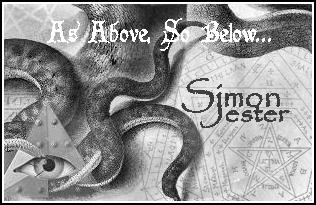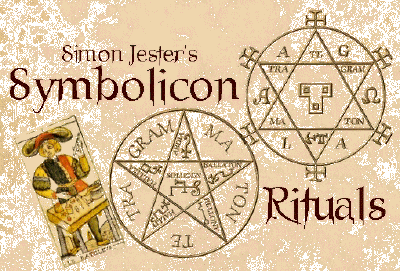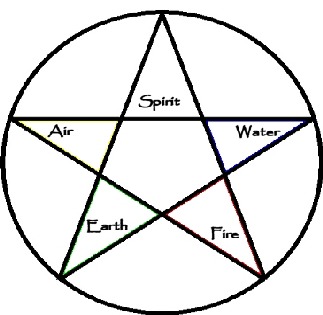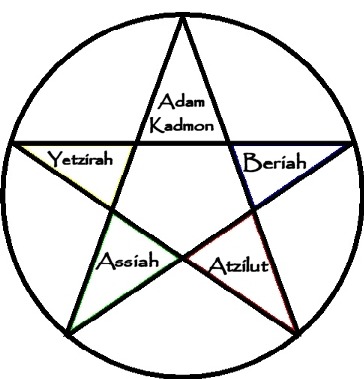Understanding the Lesser Banishing Ritual by Simon Jester
of the Pentagram
My original intent for this entry was to outline the steps of the Lesser Banishing Ritual of the Pentagram (abbreviated hereafter as the LBRP). However, I began to realize that no one should attempt to perform this ritual without having first been given some degree of understanding of its symbolism. When performing magical rituals, it is of supreme importance to understand the meaning of the symbolism employed. Simply going through the motions of a ritual without comprehending the significance of its symbolic structure renders it ineffective. The power and efficacy of a given magical operation increases in direct proportion to the degree of understanding one has of the symbolism involved. Therefore, let us examine the symbol of the pentagram, which is much more complex than popular opinion realizes, and outline some of its more important meanings.
The pentagram is a very old symbol initially deriving (as far as the current archeological record reveals) from the Sumerian culture that arose between the banks of the Tigris and Euphrates rivers approximately five thousand years ago. It may have been used by the Sumerians to indicate an enclosure or chamber of some sort, but the precise meaning of this glyph is not fully understood. Later, the Babylonians used the pentagram to symbolize five basic directions: before, behind, right, left, and up. As we shall eventually see, the LBRP still uses these basic directions during the invocation of the Archangels.
The ancient Egyptians also employed the symbol of a five-pointed star, which may be seen on the painted ceilings of temples and tombs and also on the inner lids of sarcophagi and coffins, but it was formed differently from the pentagram as it came to be commonly used in Western ritual magic. The Egyptians envisioned the stars as the Followers of Osiris, the god of rebirth, and believed that they were inhabited by the bas (spirits) of the deceased. As we shall see, this association of the five-pointed star with rebirth into a higher spiritual life is a recurring theme in the history of this symbol, and foreshadows the later initiatory significance attributed to the pentagram in the esoteric tradition.
Pythagoras and his followers inspired the Greeks with a reverence for the sacred geometry of the pentagram, and Medieval Neo-Pythagoreans were the first to associate its points with the four classical elements. They assigned the topmost controlling point to a fifth element referred to as "Idea," a Platonic concept, directly related to the Nous of the Corpus Hermeticum, which refers to the Divine Mind that creates and maintains the universe by an act of intellectual conception. In earlier Greek myths, the pentagram figured as a kind of magical container (called the Pentemychos) in which the proto-cosmic life force had first to be placed in order to form the created cosmos in an orderly fashion. This idea was echoed many centuries later in alchemy, where the pentagram occasionally symbolized the vessel in which the Great Work of creating the Philosopher's Stone came to its transformative conclusion. The ancient Greeks also viewed the pentagram as a kind of magical portal that led into and out of the underworld. This may be the origin of the pentagram's use to banish or invoke certain forces.
Beginning in the 19'th century with the popular writings of Eliphas Levi, the pentagram began to take on a growing importance as a magical symbol. Prior to Levi, of course, the pentagram had been employed in ritual magic for centuries, and one can find examples of its familiar shape in many of the medieval grimoires. But Levi was one of the first modern magicians to write explicitly about this symbol and to provide his readers with a partial explanation of its Hermetic significance. Since his time, it has become one of the primary symbols employed by magicians in their ceremonies, and the LBRP is one of the most frequently performed magical rituals in the world today.
In the Western Hermetic Tradition as it is currently practiced, the pentagram is associated with a number of distinct symbolic systems. Although differing in details of outward form and originating from diverse cultural backgrounds, these systems tap a common source of mystical/magical experience. At a level of archetypal depth, the various metaphysical systems associated with the pentagram are like views of a single landscape seen through a revolving kaleidoscope. Different facets may be distinguished, but all interpenetrate and merge into a complex unified design.
Today, people are most familiar with the pentagram because of its ubiquitous usage by Neo-Pagans who employ it to symbolize the four traditional elements of Fire, Water, Air, and Earth under the domination of the Spirit, which is seen as the fifth non-physical element, or Quintessence. As any student of modern science knows, the old Aristotelian "elements" are not really elements in the strict chemical sense at all. Most contemporary Hermeticists have therefore retained them in updated form by saying that they really refer to the four states of matter acknowledged by modern physics: Fire is plasma, Air is gas, Water is liquid, and Earth is solid. However, the literal meanings of the four Elements are only a small fraction of their much wider symbolic significance, and students of occultism view them as representing spiritual states & initiatory steps as well as physical conditions or entities. One popular scheme equates them with the composite parts of the human personality: Earth is the physical body, Water represents the emotions and feelings, Air is thought, Fire is soul, and the Fifth Element is spirit.
There are many other ways of assigning symbolic meanings to the traditional Elements, and also numerous methods of relating them to the pentagram. The most commonly employed method positions them as follows: beginning with the lower right point of the one-point-up pentagram, and moving counter-clockwise through the other points, we have Fire, Water, Spirit, Air, and Earth. This assignment fits nicely with Qabalistic traditions that associate the Elements with the Tetragrammaton, the Pentagrammaton, and the Four & Five World systems associated with the Tree of Life.
During the Renaissance, a time of intense Hermetic study and creativity, philosopher Pico della Mirandola adopted a Qabalistic tradition which related each of the traditional Elements to a letter of the Tetragrammaton, the holy four-lettered Name of God. Written right-to-left in Hebraic, the Tetragrammaton is composed of the four Hebrew letters Yod-Heh-Vau-Heh (or simply YHVH when transliterated into English.) Yod is associated with Fire, Heh with Water, Vau with Air, and the final Heh with Earth. Mirandola, a Christian Qabalist, realized that the Pentagrammaton (i.e., the five-lettered Name of the Messiah) could be formed by inserting a fifth Hebrew letter, shin, into the Tetragrammaton. This spells out the name Yod-Heh-Shin-Vau-Heh, which forms the name Yeheshua: the name "Jesus" as it was written in ancient Palestine. In Qabalistic tradition, the letter Shin is associated with the Holy Spirit.
..
The Hebrew letters of these two Names are also related to the various Worlds, or dimensions of being, postulated by Qabalists. Beginning with Isaac of Acre and the anonymous Qabalistic work Massekhet Atzilut, the Hebrew letter Yod has been associated with the World of Atzilut, Heh with Beriah, Vau with Yetzirah, and the final Heh with Assiah. Other Qabalists included a higher Fifth World that they called the World of Adam Kadmon, the Primordial Man, and this World may be assigned to the letter Shin.
The meanings of these various Worlds will be explained in later blog entries. For now, merely understand them in terms of what might be called differing levels of spiritual intensity, with Shin/Adam Kadmon /Spirit as the most spiritually intense World, followed by the Worlds of Yod/Atzilut/Fire, Heh/Beriah/Water, Vau/Yetzirah/Air, and the final Heh/Assiah/Earth in descending order of spiritual intensity. To supply a reference point, the World of Assiah at the bottom of this spiritual hierarchy is the material world of so-called "common sense reality." On the metaphysical map that you use everyday to orient yourself, put a big "X—You Are Here" on Assiah.
In addition to providing a visually organized diagram of the Tetragrammaton, the Pentagrammaton, and the five Qabalistic Worlds, the pentagram also symbolizes the spiritual status that a person attains after passing through an initiation experience that results in a state of awakening, enlightenment, and higher consciousness. For ritual magicians, this is the real hidden meaning of the pentagram, the all-important psychological/spiritual significance that gives the symbol its great power.
This significance is hinted at by the assignment of Adam Kadmon to the topmost point of the pentagram. In the Qabala, Adam Kadmon is the Anthropos: the Primordial Man or Ideal Human Being, who is reflected downward into matter to be instantiated in a latent form in each individual person. He is the God in whose image we are made according to the Book of Genesis, and represents the ultimate potential that can be attained by human consciousness. In Isaac Luria's system of Qabala, Adam Kadmon exists closest to the undifferentiated Supreme Being and was the intermediary agency that emanated all the Sephiroth that make up the Tree of Life and the various lower Worlds. By placing Adam Kadmon, the archetypal Human, at the top of the pentagram, a symbol is created which asserts the divine potential of human nature and shows elevated humanity in a state of conscious, enlightened command over all the forces represented by the Four Elements in the Four Lower Worlds, i.e. the entire created cosmos. No wonder Eliphas Levi says that all demons and lower spiritual entities cringe in fear and flee at the sign of the pentagram! The person who wields this magical symbol proclaims his or her Divine Birthright to a position of supreme power over all creation.
When applied to the pentagram, Pico della Mirandola's interpretation of the relationship between the Tetragrammaton and the Pentagrammaton provides a Christianized reflection of Judaic symbolism which assigns the role of the archetypal ideal human to Yeheshua-Christ rather than to the Qabalistic Adam Kadmon. Christ's perfect embodiment of the Holy Spirit, symbolized by the letter Shin at the apex of the pentagram, places Him in command of the elements out of which all things are created and composed. In the Hermetic tradition, Christ-consciousness is seen as a state of ultimate spiritual awareness that all humans may potentially attain. The pentagram symbolizes this attainment as the end-point of a process of initiation-enhanced evolution that passes through four developmental stages of spiritual growth and expanding consciousness before attaining the fifth and ultimate stage of enlightenment. One version of the initiatory steps of this process is given in the Gnostic Gospel of Philip (saying 68 of the Wilson translation) as the Five Gnostic Sacraments: "The Lord worked all things as a mystery; a baptism, an anointing and a Eucharist and a redeeming, and a bride-chamber." In this Gnostic scheme, the "bride-chamber" is the final and highest destination and refers to the Mystical Wedding between Christ and the Holy Spirit, or the Shekinah.
The associations of Christ with the pentagram are extensive and date back to the very beginnings of Christianity when Constantine, the First Holy Roman Emperor, adopted the five-pointed star as his official seal. The pentagram may actually have adorned the walls of some of the first Christian churches instead of the Cross or Crucifix, which eventually came to replace it as the central alter symbol displayed in places of worship. It was used by early Christians to symbolize the Five Wounds of Christ. In Hermetic circles, these Five Wounds symbolize the five physical senses that "crucify" every human on the "cross" of the material world. Again, in this Christianized Hermetic interpretation, we find the recurring theme of the pentagram as a symbol of human spiritual potential. Incarnation via birth binds everyone, just as Christ was bound, to the world of the senses. And, like Christ, we may "marry" and embody the Holy Spirit and thereby redeem and elevate our material natures to their highest spiritual potential.
Many people are surprised to learn that the pentagram is still employed today as a prominent Christian symbol by mainstream denominations, especially in a day and age when people with no understanding of the multivalent function of symbolism see Satan's cloven hoof-prints around every five-pointed star. Methodists use the inverted pentagram as a symbol of the Trinity because it is formed out of three interlocked triangles, and the Order of the Eastern Star, which is a Masonic affiliate with close ties to the Presbyterian church, also uses the symbol of an inverted pentagram as their organization's insignia.
As you will have realized by now, the pentagram possesses a very rich & complex meaning in ritual magic, one that includes yet transcends its popular "New Age" interpretation as a symbol of the Four Elements under the domination of the Spirit. In its current incarnation, the pentagram embodies Qabalistic, Hermetic, Gnostic, and Christian accretions along with traits attributable to its ancient Babylonian, Egyptian and Greek heritage. In the LBRP, you will learn to project a specific form of this ancient symbol (an Earth Banishing Pentagram) into each quarter of the compass—East, South, West, and North. You will visualize an encircling line of light connecting these pentagrams and forming a Magic Circle around yourself. Within this circle, you will be safe to conduct other kinds of magical operations.
The LBRP magically cleanses and purifies an area by banishing all negative influences to a metaphysical dimension outside of the circle. But it is also much more than this. Aleister Crowley once stated that those who consider this ritual as just a simple banishing procedure are unworthy to possess it. Crowley had all the deeply spiritual and initiatory meanings of the pentagram in mind when he made this statement. The pentagram is indeed a powerful protective and banishing symbol, but it possesses this power only because of its deeper meanings, some of which have been discussed above.
In addition to the symbols of the Pentagram and the Magic Circle, the LBRP employs other symbolic features that possess a deeper meaning than one might initially realize. When performing this ritual, you symbolically place yourself at a very powerful metaphysical location on two of the Paths that connect various Sephiroth of the Qabalistic Tree of Life. This astral location is what might be called a Power Point: a place where two Paths intersect, blend, and focus their magnified energies. The act of banishing the Earth and taking up a position at this particular magical crossroads, surrounded by potent symbols of initiation and spiritual transformation, is laden with great significance which will be more fully explained in the next blog entry.




